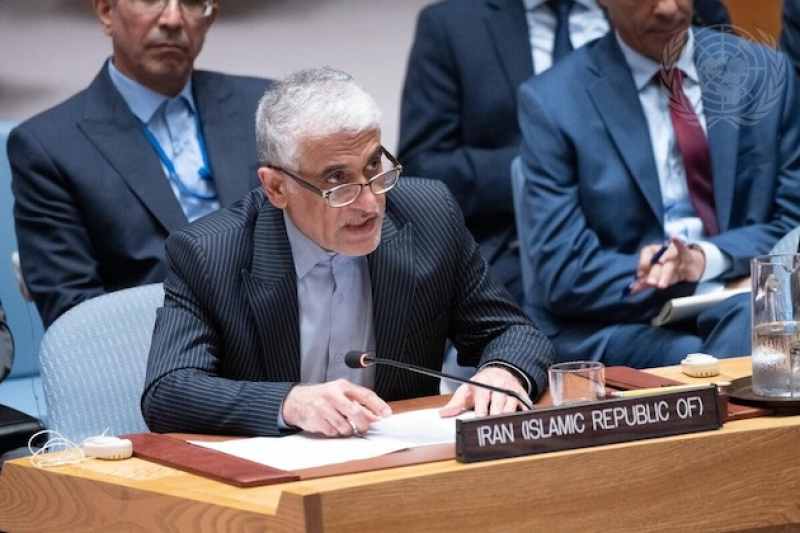- Intimidation or bloodshed cannot halt Bangladesh’s march to democracy |
- Khaleda Zia integral to an important chapter in BD history: Yunus |
- Enthusiasm marks Victory Day celebrations across Bangladesh |
- Dhaka-Delhi ties deep; to be shaped by trust, dignity, mutual respect |
- EU deploys election observation mission to Bangladesh |
Sectarian Clashes in Syria Deepen Humanitarian Crisis

Amir Saeid Iravani, Permanent Representative of the Islamic Republic of Iran to the United Nations, addresses the Security Council meeting on the situation in the Middle East (Syria).
As sectarian violence escalates in Syria, the number of displaced people has increased dramatically since Syrian forces became involved in clashes between the Druze and Bedouin communities in the Sweida region.
Stéphane Dujarric, spokesperson for the UN Secretary-General, reported at Wednesday’s daily press briefing: “More than 145,000 people have now been displaced due to hostilities in the Suweida governorate.” This marks a rise of over 50,000 people since Monday, when the number stood at 93,000.
The conflict began as a dispute between the Druze and Bedouin—two minority groups in southern Syria. In Sweida, a Druze-majority city, armed government forces were deployed to quell the violence and regain control of local government structures, which were primarily led by Druze officials.
However, following an Israeli airstrike on Damascus—citing threats to Druze civilians—Israeli Prime Minister Benjamin Netanyahu outlined a plan to demilitarise Syrian territory “from south of Damascus and the Golan Heights to the Druze Mountain.”
This move drew widespread criticism from international actors, including UN Secretary-General António Guterres, who stressed: “It is essential that these attacks stop and that Israel respect Syria’s sovereignty, unity, territorial integrity, and independence.”
Israel is just one of many foreign powers entangled in Syria’s political and military conflict. During the Syrian civil war, a broader pro-democracy uprising across the Middle East, countries such as Iran and Russia backed the Assad regime, aiming to counter Western influence. In contrast, Turkey, the United States, and Gulf nations like Saudi Arabia and Qatar supported various rebel factions, each pursuing their own strategic and ideological interests.
As a result, Syria has become a battleground not only for internal rivalries but also for regional and global powers—often with devastating consequences for civilians.
According to the World Health Organization (WHO), more than 15.8 million people across Syria were in need of humanitarian assistance as of March 2025—the highest figure since the conflict began in 2011. The intensifying violence in Sweida further exacerbates the crisis and places additional strain on an already overstretched aid system.
Medical services have been severely affected. The Euro-Med Human Rights Monitor reports that only 57 percent of hospitals and 37 percent of primary healthcare centres are functioning at full capacity. Many others are struggling due to damaged infrastructure, medicine shortages, and the exodus of medical personnel.
UNDP assessments reveal that there is now only one doctor per 2,000 people due to decades of migration. The decline in public health spending has left healthcare systems particularly vulnerable at a time of increasing violence.
Infrastructure challenges extend beyond healthcare. UNDP reports that between 30 and 50 percent of schools are out of service—damaged, destroyed, or repurposed due to war-related destruction or lack of maintenance. Operational schools often lack basic utilities like water, electricity, or heating due to limited state funding.
UNICEF has raised alarms about the impact of the conflict on children, estimating that over 2.4 million children are currently out of school, many of whom have been displaced multiple times.
“Years of war and violence have shattered the lives of Syria’s children, with many enduring a lifetime of hardship,” said UNICEF Executive Director Catherine Russell. This lack of educational continuity is hindering Syria’s ability to rebuild its healthcare and education sectors, contributing to long-term stagnation.
Fragile governance structures have also hampered humanitarian access. In recent years, the UN Security Council has failed to renew vital cross-border aid mechanisms due to vetoes from permanent members, leaving aid delivery reliant on unstable domestic routes.
In a recent Geneva press briefing, it was confirmed that humanitarian convoys have been delayed or blocked from reaching Sweida and Daraa due to ongoing fighting and a lack of security guarantees.
As Syria’s central government loses its grip, with local militias and foreign powers carving out zones of control, civilians are increasingly left without protection or access to basic services. The renewed violence in Sweida illustrates the dire consequences of this fragmentation: a fragile region overwhelmed by displacement, cut off from aid, and vulnerable to indiscriminate attacks.

